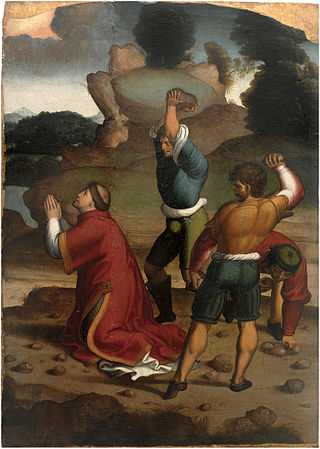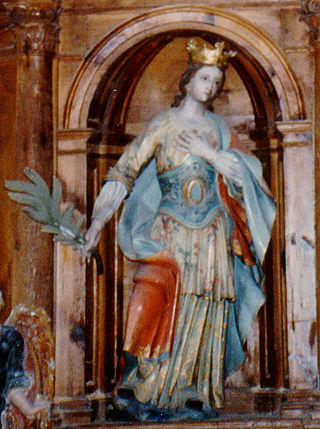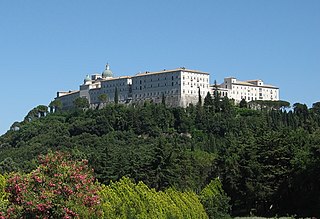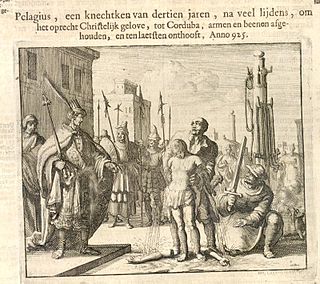Related Research Articles
Theodemir or Theudimer was a Visigothic comes (count) prominent in the southeast of Carthaginensis during the last decades of the Visigothic kingdom and for several years after the Moorish conquest. He ruled seven cities in southeastern Spain, mentioned in the Treaty of Orihuela that was preserved by the Andalusian historian Ibn Adarí in the thirteenth century: Orihuela, Valentila, Alicante, Mula, Bigastro, Eyya, and Lorca.

In Christianity, a martyr is a person considered to have died because of their testimony for Jesus or faith in Jesus. In years of the early church, stories depict this often occurring through death by sawing, stoning, crucifixion, burning at the stake or other forms of torture and capital punishment. The word martyr comes from the Koine word μάρτυς, mártys, which means "witness" or "testimony".
Lynn Townsend White Jr. was an American historian. He was a professor of medieval history at Princeton from 1933 to 1937, and at Stanford from 1937 to 1943. He was president of Mills College, Oakland, from 1943 to 1958 and a professor at University of California, Los Angeles from 1958 until 1987. Lynn White helped to found the Society for the History of Technology (SHOT) and was president from 1960 to 1962. He won the Pfizer Award for "Medieval Technology and Social Change" from the History of Science Society (HSS) and the Leonardo da Vinci medal and Dexter prize from SHOT in 1964 and 1970. He was president of the History of Science Society from 1971 to 1972. He was president of The Medieval Academy of America from 1972–1973, and the American Historical Association in 1973.

The Martyrs of Córdoba were forty-eight Christian martyrs who were executed under the rule of Muslim administration in Al-Andalus. The hagiographical treatise written by the Iberian Christian and Latinist scholar Eulogius of Córdoba describes in detail the executions of the martyrs for capital violations of Islamic law (sharīʿa), including apostasy and blasphemy. The martyrdoms recorded by Eulogius took place between 850 and 859 AD, which according to the Mālikī judges of al-Andalus broke the treaty signed between Muslims and their Christian subjects.

Liuva I was a Visigothic King of Hispania and Septimania.

Columba of Spain was a virgin and nun who was born in Córdoba, Spain, and martyred around 853 by the Muslim rulers in Spain, during a persecution of Christians. She is a part of the Martyrs of Córdoba and venerated as a saint in the Catholic Church. Her feast day is September 17. Her cult was probably a combination of two virgin martyrs, Colomba of Spain and Columba of Sens, a third century French martyr.
GaufredoMalaterra was an eleventh-century Benedictine monk and historian, possibly of Norman origin. He travelled to the southern Italian peninsula, passing some time in Apulia before entering the monastery of Sant'Agata at Catania, on the isle of Sicily. Malaterra indicates that, prior to his arrival in Catania, he had spent an undefined period away from monastic life, in the worldly service of "Martha".
William of Apulia was a chronicler of the Normans, writing in the 1090s. His Latin epic, Gesta Roberti Wiscardi, written in hexameters, is one of the principal contemporary sources for the Norman conquest of southern Italy, especially the career of Robert Guiscard, Duke of Apulia (1059–1085).

Amatus of Montecassino, was a Benedictine monk of the Abbey of Montecassino who is best known for his historical chronicles of his era. His History of the Normans, is one of three principle primary sources for the Norman Conquest of southern Italy--the other two being the histories of William of Apulia and Geoffrey Malaterra. Amatus describes the Normans from the perspective of his abbey, one of the most important religious and cultural centers in Italy at the time. His history is the earliest extant account of the Norman sieges of Bari and Salerno, their conquest of Sicily, and the careers of both Robert Guiscard and Richard Drengot, as well as the Gregorian Reforms seen from the papal point of view.

Pelagius of Córdoba was a Christian boy who died as a martyr in Córdoba in southern Spain around 926 AD.

Kenneth John Conant was an American architectural historian and educator, who specialized in medieval architecture. Conant is known for his studies of Cluny Abbey.
Gabrielle Michele Spiegel is an American historian of medieval France, and the current Krieger-Eisenhower Professor of History at Johns Hopkins University where she served as chair for the history department for six years, and acting and interim dean of faculty. She also served as dean of humanities at the University of California, Los Angeles in 2004–2005, and, from 2008 to 2009, she was the president of the American Historical Association. In 2011, she was elected as a fellow to the American Academy of Arts and Sciences.
Dryhthelm, also known as Drithelm or Drythelm, was a monk associated with the monastery of Melrose known from the Historia Ecclesiastica gentis Anglorum of Bede. According to the latter, before entering the religious life he lived with his family in "a district of Northumbria which is called Incuneningum". Incuneningum is thought by some modern scholars to refer to Cunninghame, now part of Ayrshire.
The first plague pandemic was the first historically recorded Old World pandemic of plague, the contagious disease caused by the bacterium Yersinia pestis. Also called the early medieval pandemic, it began with the Plague of Justinian in 541 and continued until 750 or 767; at least fifteen or eighteen major waves of plague following the Justinianic plague have been identified from historical records. The pandemic affected the Mediterranean Basin most severely and most frequently, but also infected the Near East and Northern Europe, and potentially East Asia as well. The Roman emperor Justinian I's name is sometimes applied to the whole series of plague epidemics in late Antiquity, as well as to the Plague of Justinian which struck the Eastern Roman Empire in the early 540s.
Robert of Cricklade was a medieval English writer and prior of St Frideswide's Priory in Oxford. He was a native of Cricklade and taught before becoming a cleric. He wrote several theological works as well as a lost biography of Thomas Becket, the murdered Archbishop of Canterbury.
Elizabeth Eva Leach is a British musicologist and music theorist who specializes in medieval music, especially that of the fourteenth century.
Aurea of Córdoba (810–856) was a saint, nun, and martyr, part of the Martyrs of Córdoba, a group of 48 Christian martyrs executed during Muslim rule in al-Andalus. Aurea's feast day is 19 July.
The commenda was a medieval contract which developed in Italy around the 10th century, and was an early form of limited partnership. The commenda was an agreement between an investing partner and a traveling partner to conduct a commercial enterprise, usually overseas. The terms of the partnership varied, and are usually categorized by modern historians as unilateral commenda and bilateral commenda, based on the share of contributions and profits between the partners. The bilateral commenda was known in Venice as colleganza or collegantia. The commenda has been described as a foundational innovation in the history of finance and trade.
Emily Steiner is the Rose Family Endowed Chair Professor of English at the University of Pennsylvania. She is known for her work on medieval literature and middle English literature and culture.
References
- ↑ "Wolf, Kenneth Baxter 1957–". Encyclopedia.com . Retrieved December 4, 2020.
- ↑ "Kenneth Baxter Wolf". Pomona College. May 29, 2015. Retrieved December 4, 2020.
- ↑ Matheny, William E. (1990). "Christian Martyrs in Muslim Spain. By Kenneth Baxter Wolf. Cambridge Iberian and Latin American Studies. New York: Cambridge University Press, 1988. xi + 147 pp. $34.50". Church History. 59 (1): 75–76. doi:10.2307/3169091. ISSN 1755-2613. JSTOR 3169091. S2CID 161498500.
- ↑ Glick, Thomas F. (April 1989). "Christian Martyrs in Muslim Spain . Kenneth Baxter Wolf". Speculum. 64 (2): 512. doi:10.2307/2852021. JSTOR 2852021.
- ↑ Percy, William A. (April 1, 1996). "Making History: The Normans and Their Historians in Eleventh-Century Italy. Kenneth Baxter Wolf". Speculum. 71 (2): 507–508. doi:10.2307/2865486. JSTOR 2865486.
- ↑ Chinnici, Joseph P. (April 15, 2004). "The Poverty of Riches, St. Francis of Assisi Reconsidered (review)". Spiritus: A Journal of Christian Spirituality. 4 (1): 98–101. doi:10.1353/scs.2004.0006. ISSN 1535-3117. S2CID 144687130 . Retrieved June 1, 2017.
- ↑ Collins, Roger (January 1993). "Conquerors and Chroniclers of Early Medieval Spain. Translated by Baxter WolfKenneth. (Translated Texts for Historians, ix.) Pp. xvii + 203 incl. map and plate. Liverpool: Liverpool University Press, 1990. £8.50, 0 85323 047 1". The Journal of Ecclesiastical History. 44 (1): 151–152. doi:10.1017/s0022046900010563. ISSN 1469-7637. S2CID 161806178 . Retrieved June 1, 2017.
- ↑ Drell, Joanna (January 1, 2009). "Kenneth Baxter Wolf, trans. The Deeds of Count Roger of Calabria and Sicily, and of His Brother Duke Robert Guiscard by Geoffrey Malaterra". The Journal of Medieval Latin. 19: 346–350. doi:10.1484/j.jml.3.47. ISSN 0778-9750 . Retrieved June 1, 2017.
- ↑ Gecser, Ottó (January 2013). "The life and afterlife of St Elizabeth of Hungary. Testimony from her canonization hearings. Edited by Kenneth BaxterWolf. Pp. xviii + 230. New York–Oxford: Oxford University Press, 2011. £45. 978 0 19 973258 6". The Journal of Ecclesiastical History. 64 (1): 155–156. doi:10.1017/s002204691200259x. ISSN 0022-0469. S2CID 163580027 . Retrieved June 1, 2017.
- ↑ Pieper, Lori (February 15, 2012). "The Life and Afterlife of St. Elizabeth of Hungary: Testimony from Her Canonization Hearings (review)". The Catholic Historical Review. 98 (1): 104–105. doi:10.1353/cat.2012.0006. ISSN 1534-0708. S2CID 162156003 . Retrieved June 1, 2017.